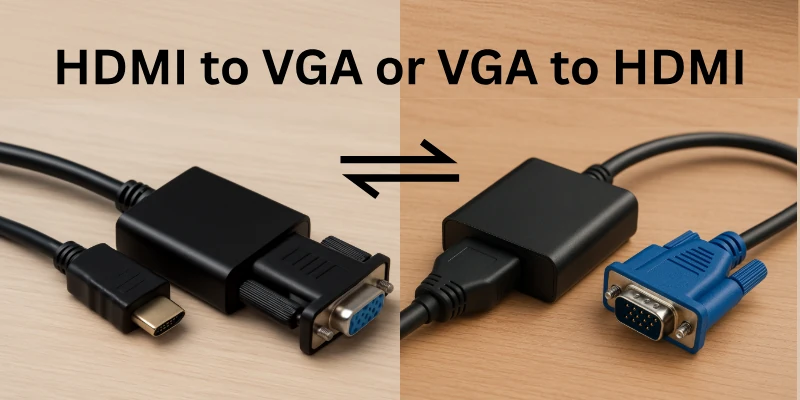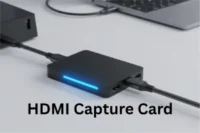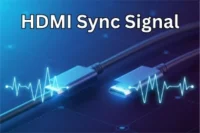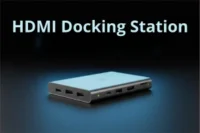HDMI to VGA or VGA to HDMI: Complete How-To Guide
Published: 14 Aug 2025
Many modern computers, laptops, and TVs use HDMI (High-Definition Multimedia Interface) for video and sound. However, older devices like some monitors and projectors still use VGA (Video Graphics Array).

If your computer has only an HDMI port but your monitor has only a VGA port, you need a converter to connect them. The same applies if your computer has only a VGA port but your monitor has only an HDMI port.
This guide explains how to convert HDMI to VGA or VGA to HDMI, addressing some signal quality issues and limitations. It also provides alternative methods using the best recommended VGA to HDMI adapters.
How to Convert VGA to HDMI (Old Computer to New Monitor/TV)
Here, we will learn how to connect an old computer that has only a VGA port to a new monitor or TV that has only an HDMI port.
Since VGA is an older technology that does not support high-definition (HD) video or audio, we need a VGA to HDMI converter to make the connection work.
What You Need
Before we start, you will need the following items:
- VGA to HDMI Converter – This device changes VGA signals into HDMI so your new monitor or TV can display the image properly.
- VGA Cable – This connects your computer’s VGA port to the converter’s VGA input.
- HDMI Cable – This connects the converter’s HDMI output to your new monitor or TV.
- Audio Cable – Since VGA does not carry sound, this cable is needed if you want audio from your computer to play on the monitor’s speakers.
- Power Cable – Some converters need extra power, which they get through a USB port.
Steps to Connect
Now, let’s go through the process step by step
- Connect the VGA Cable
- Take one end of the VGA cable and plug it into the VGA port on your computer.
- The VGA port is usually blue and has small holes for pins.
- If your VGA cable has screws on the sides, tighten them gently to secure the connection.
- Connect the Audio Cable (If Needed)
- VGA does not carry audio, so if you need sound, use a 3.5mm audio cable (the same kind used for headphones).
- Plug one end of the audio cable into your computer’s headphone jack.
- Plug the other end into the audio input on the VGA to HDMI converter.
- Plug the HDMI Cable
- Take an HDMI cable and plug one end into the HDMI output port of the converter.
- Plug the other end into the HDMI port on your monitor or TV.
- Power the Converter (If Required)
- Some converters need power to work.
- If your converter has a USB power cable, plug it into a USB port on your computer or use a USB power adapter.
- Turn On Your Devices
- Power on your computer and monitor/TV.
- Wait for a few seconds for them to detect the connection.
- Select HDMI as the Input Source
- On your monitor or TV, press the input/source button on the remote or device.
- Choose HDMI from the options.
- Your computer screen should now appear on the monitor or TV.
- Check Display Settings
- If the image looks too small or stretched, adjust the screen resolution on your computer.
- On Windows, go to Settings > Display > Resolution and choose the best option for your screen.
Important Notes
Here are some points to be noted:
- VGA is an old technology and does not support high-definition video like HDMI does. The image quality will remain the same as VGA’s original quality.
- Using a converter does not improve the video quality; it only allows the connection to work.
- If you have a desktop computer with only a VGA port, consider upgrading your graphics card to one that supports HDMI for better quality.
How to Convert HDMI to VGA (New Computer to Old Monitor/Projector)
Here, we will learn how to connect a new computer, laptop, or gaming console that has only an HDMI port to an old monitor or projector that has only a VGA port.
Since HDMI is a digital signal that carries both video and audio, while VGA is an analog signal that carries only video, we need an HDMI to VGA adapter to make the connection work.
What You Need
Before we start, you will need the following items:
- HDMI to VGA Adapter – This device changes the HDMI signal into VGA, allowing your computer to connect to an older monitor or projector.
- VGA Cable – This cable connects the adapter’s VGA output to your monitor or projector’s VGA input.
- Audio Cable (If Needed) – If your adapter does not support audio, you may need this cable to get sound from your computer.
- Power Cable (If Required) – Some adapters need extra power and use a USB port for this.
Steps to Connect
Now, let’s go through the process step by step.
- Plug the HDMI Adapter into Your Computer
- Take your HDMI to VGA adapter and plug its HDMI end into the HDMI port of your computer, laptop, or gaming console.
- Make sure it fits securely into the port.
- Connect the VGA Cable
- Take a VGA cable and plug one end into the adapter’s VGA output.
- Plug the other end into the VGA input port on your monitor or projector.
- Connect an Audio Cable (If Needed)
- HDMI carries both video and audio, but VGA only supports video.
- If your adapter does not have built-in audio support, you may need an audio cable.
- Plug one end into your computer’s headphone jack and the other into external speakers or a separate sound system.
- Power the Adapter (If Required)
- Some adapters need extra power to work.
- If your adapter has a USB power cable, plug it into a USB port on your computer or use a USB power adapter.
- Turn On Your Devices
- Power on your computer and monitor/projector.
- Wait a few seconds for them to detect the connection.
- Select VGA as the Input Source
- On your monitor or projector, press the input/source button.
- Choose VGA from the list of available options.
- Your computer screen should now appear on the monitor or projector.
- Check Display Settings
- If the image looks blurry or stretched, adjust the screen resolution on your computer.
- On Windows, go to Settings > Display > Resolution and choose the best resolution for your screen.
Important Notes
Here are some of the major points to be noted:
- VGA does not support audio, so you may need separate speakers for sound.
- Using an adapter may slightly reduce video quality because VGA is an older, lower-resolution format.
- If your monitor only has a VGA port, consider upgrading to a newer monitor that supports HDMI for better video quality.
Understanding Signal Quality
When converting between VGA and HDMI, it is important to understand how signal quality works.
VGA vs. HDMI
- VGA is an older technology that uses analog signals, which can suffer from interference and lower resolution.

- HDMI is a modern digital format that supports high-definition video and audio without any loss of quality.
How Does Conversion Affect Quality?
- Converting VGA to HDMI does not improve the video quality. The signal remains the same as the original VGA quality.
- Converting HDMI to VGA may cause a small loss of video quality since VGA does not support high-definition video.
- For the best experience, use HDMI whenever possible to get clearer video and sound.
By following these steps, you can successfully connect your new computer or gaming console to an older VGA monitor or projector using an HDMI to VGA adapter.
Alternative Ways to Connect HDMI and VGA Devices
Sometimes, using a direct HDMI to VGA or VGA to HDMI adapter may not be the best or only solution. Here are some alternative ways to connect your devices based on your available ports and needs.
1. Using a Different Video Port (DVI or DisplayPort)
Many modern computers and monitors have additional video ports like DVI (Digital Visual Interface) or DisplayPort that may work better than VGA.
- DVI to HDMI – If your computer has a DVI port, you can use a DVI to HDMI cable instead of a VGA adapter.
- DisplayPort to HDMI/VGA – If your device has DisplayPort, you can use a DisplayPort to HDMI or VGA adapter to connect your screen.
Why Use This? These options offer better quality than VGA, with higher resolution and better color accuracy.
2. Upgrading Your Graphics Card (For Desktops)
If your PC only has a VGA output, and you need HDMI, the best long-term solution is upgrading your graphics card.
- A modern graphics card will have HDMI, DisplayPort, or DVI outputs.
- This allows direct HDMI connections without needing a VGA adapter.
- It also improves video quality and supports higher resolutions.
Why Use This? If you’re using an old desktop computer, upgrading the graphics card is a better investment than relying on adapters.
3. Using a USB to HDMI Adapter (For Laptops & PCs)
If your computer does not have HDMI or VGA, another option is a USB to HDMI adapter.
- USB to HDMI Adapter – Converts your USB port into an HDMI output.
- USB to VGA Adapter – Converts your USB port into a VGA output.
- Works well for laptops that lack VGA or HDMI ports.
Why Use This? Great for ultrabooks, older laptops, or desktops without video outputs.
4. Using a Wireless HDMI Adapter (For TVs & Projectors)
If you want to avoid cables, you can use a wireless HDMI adapter to connect your laptop or PC to a TV or projector.
- Miracast or Chromecast – Works for wirelessly displaying your screen.
- Wireless HDMI Extenders – Transmit HDMI signals over WiFi.
- Apple AirPlay – For MacBooks and Apple devices, use AirPlay to connect wirelessly to an Apple TV.
Why Use This? Perfect for presentations, streaming, and reducing cable clutter.
Which Alternative Should You Choose?
Here is the quick guide for you guys:
| Your Situation | Best Alternative Solution |
| My PC only has VGA, but I need HDMI | Upgrade the graphics card or use VGA to HDMI adapter |
| My laptop has only USB ports | USB to HDMI/VGA adapter |
| I want to connect wirelessly | Wireless HDMI adapter (Miracast, Chromecast, etc.) |
| My PC has DisplayPort or DVI | Use a DisplayPort/DVI to HDMI cable |
Where to Buy a VGA to HDMI or HDMI to VGA Adapter?
Based on ratings, compatibility, and performance, these are some of the best VGA to HDMI adapters you can buy on Amazon.
1. Moread HDMI to VGA Adapter (Best Seller)
- Rating: 4.6/5 (57,970+ Ratings)
- Reliable Performance: Gold-plated connectors for a stable connection.
- Broad Compatibility: Works with laptops, desktops, projectors, monitors, Raspberry Pi, Roku, Xbox, and more.
- No Extra Power Needed: Plug & play design.
- Compact & Lightweight: Easy to carry for business or travel use.
- Buy on Amazon: Click Here
2. BENFEI HDMI to VGA Adapter (Amazon’s Choice)
- Rating: 4.6/5 (57,322+ Ratings)
- High Performance: Gold-plated HDMI connector for durability.
- Wide Compatibility: Supports PCs, laptops, gaming consoles (PS3, Xbox, Roku), projectors, and HDTVs.
- Stable Signal Transmission: High-quality chipset ensures smooth video output.
- Buy on Amazon: Click Here
3. BENFEI HDMI to VGA 6-Foot Cable (Best for Direct Connection)
- Rating: 4.4/5 (72,499+ Ratings)
- All-in-One Solution: HDMI to VGA cable (6 feet) for direct connection (no extra VGA cable needed).
- Compatible with Various Devices: Works with PCs, laptops, monitors, projectors, and TVs.
- Affordable & Durable: Good for budget-conscious buyers.
- Buy on Amazon: Click Here
4. BENFEI VGA to HDMI Adapter with Audio (Best for Old PCs & Laptops)
- Rating: 4.5/5 (5,842+ Ratings)
- Supports Audio & Video: Unlike basic adapters, this one includes an audio jack.
- 1080p HD Support: Converts VGA video signals to HDMI without lag.
- Ideal for Old Computers & Laptops: If your PC has only a VGA port, this adapter is perfect.
- Buy on Amazon: Click Here
5. BENFEI HDMI to VGA Adapter with Audio (Budget-Friendly Option)
- Rating: 4.4/5 (8,355+ Ratings)
- Includes a 3.5mm Audio Jack: Transmits both video and sound.
- Plug & Play: No drivers needed.
- Works with TV Sticks, Laptops, and More: Supports Roku, Xbox, PCs, and monitors.
- Buy on Amazon: Click Here
How to Choose the Best VGA to HDMI Adapter?
- Check if you need audio support (some VGA adapters do not transmit sound).
- Look for a high-quality chipset for smooth video conversion.
- Choose an adapter with gold-plated connectors for better durability.
- Consider a cable option if you want an all-in-one connection.
Conclusion
In this article, we’ve covered how to convert HDMI to VGA or VGA to HDMI in detail. If you’re looking for a reliable and budget-friendly option, I personally recommend the Moread HDMI to VGA Adapter, as it offers stable performance and excellent compatibility.
However, if you need audio support, the BENFEI VGA to HDMI Adapter with Audio is a great choice. Have you tried any of these adapters before? Let me know your thoughts in the comments below!
FAQs
There are some common questions about HDMI to VGA or VGA to HDMI after reading all the above:
No, it’s not that simple! HDMI sends digital signals, while VGA uses analog. A direct cable won’t work because they speak different “languages.” You need an active adapter to change the signal properly. Without it, your screen will stay black!
Most adapters work only one way—either HDMI to VGA or VGA to HDMI. If you try using it the other way, it won’t work. If you need both, buy a bi-directional adapter that supports both directions. Always check the product details before buying!
Not exactly! VGA is older and doesn’t support high-definition like HDMI. If you’re converting from HDMI to VGA, the picture might look a little less sharp. Text may not be as clear, and colors might be slightly different. But for normal use, it still works fine!
Yes! VGA only carries video, so you won’t get any sound from it. If you need audio, you must use a separate audio cable from your device. Some HDMI to VGA adapters come with an audio output—check for that! Otherwise, use speakers or headphones.
There could be a few reasons! First, make sure you’re using the right type (one-way or bi-directional). Some adapters need external power, so check if it has a power port. Also, try using a different HDMI or VGA cable—sometimes, cables are the issue. If nothing works, the adapter might be faulty.
Flickering usually means a weak connection or resolution mismatch. First, check if the adapter and cables are plugged in properly. Then, go to your display settings and try lowering the resolution. If the problem continues, your adapter might not be powerful enough—consider getting a better one.
Yes, if possible, use a direct connection—HDMI to HDMI or VGA to VGA. Adapters work, but they reduce quality a little. If your monitor or TV has both ports, always choose HDMI for the best performance. But if you must use an adapter, pick a good quality one to avoid problems!

- Be Respectful
- Stay Relevant
- Stay Positive
- True Feedback
- Encourage Discussion
- Avoid Spamming
- No Fake News
- Don't Copy-Paste
- No Personal Attacks

- Be Respectful
- Stay Relevant
- Stay Positive
- True Feedback
- Encourage Discussion
- Avoid Spamming
- No Fake News
- Don't Copy-Paste
- No Personal Attacks





